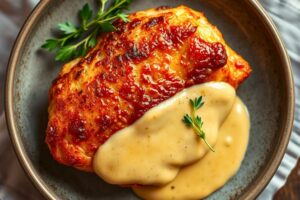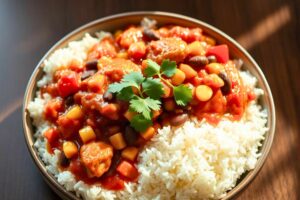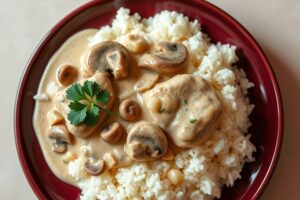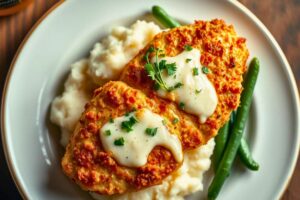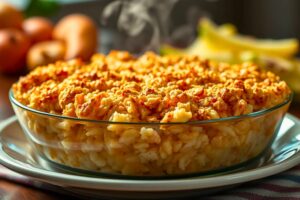You know that moment when the day’s been too much, and you need a dinner that feels like it gets you? Not something fancy or fussy, just warm, familiar, and easy to love. That’s when I turn to Chicken Piccata, the kind of dish that doesn’t need an occasion. It shows up for you on the messy days, the ones where comfort matters more than presentation.
I had one of those days recently. Nothing big went wrong, but everything felt slightly off. The kind of day where even a full fridge feels empty. I opened the door and spotted a single lemon rolling around like it had been waiting for me. That’s when it hit me Chicken Piccata. Tangy, buttery, and kissed with briny capers. I grabbed what I had and got to work. Garlic sizzling in golden butter, chicken searing to crisp perfection, and that citrusy aroma wrapping around the kitchen like a soft blanket.
There’s something healing in the rhythm of making this dish. It’s not just food, it’s an exhale. A pause. A reminder that something simple can still feel special. I’ll walk you through every step of this cozy classic, and I promise once you try it, Chicken Piccata will be the dish you reach for too.
The Heart of Great Chicken Piccata
Let me tell you something that changed my entire relationship with this dish. Most people think piccata is about the chicken, but it’s really about the sauce. That silky, tangy, wine kissed sauce makes everything taste like it came from a five star restaurant. It’s the soul of a great, comforting Italian dish.
The secret lies in understanding what piccata actually means; it’s Italian for “pounded thin.” Originally, cooks used this technique to tenderize tougher cuts of meat, but when Italian immigrants brought it to America, they adapted it for chicken. The result? Pure genius. That’s how Chicken Piccata found its classic form.
Here’s what separates restaurant quality piccata from sad, soggy versions: timing and technique. Every step builds on the last one, creating layers of flavor that’ll make your taste buds sing. Mastering Chicken Piccata is all about respecting those steps.
Ingredients That Actually Matter
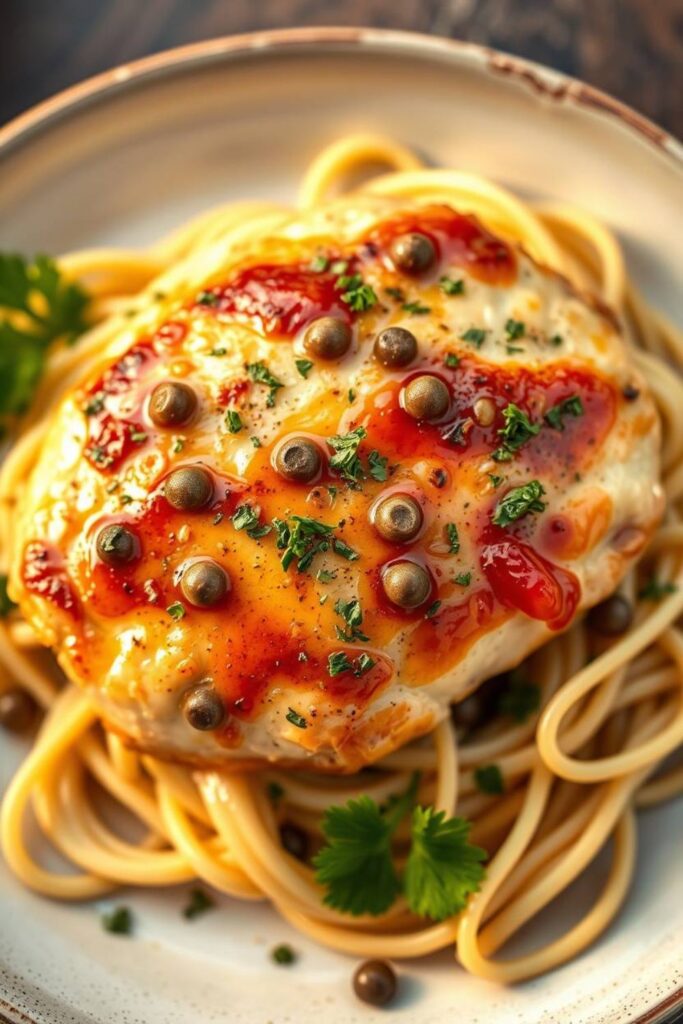
For the Chicken:
- 2 large boneless, skinless chicken breasts (about 1.5 pounds)
- 1 cup all purpose flour
- 1 teaspoon salt
- ½ teaspoon black pepper
- 2 tablespoons olive oil
- 3 tablespoons butter, divided
For the Sauce:
- ½ cup dry white wine (don’t cook with anything you wouldn’t drink)
- ⅓ cup fresh lemon juice (about 2 large lemons)
- 3 tablespoons capers, drained
- 2 cloves garlic, minced
- 2 tablespoons fresh parsley, chopped
- 1 tablespoon butter for finishing
Now, let’s talk smart swaps because life happens. Ingredients aren’t always available.
Can’t find capers? Green olives chopped fine work in a pinch. You’ll lose some of that distinctive briny pop though. No white wine? Mix chicken broth with a splash of white wine vinegar. Out of fresh lemons? Please don’t use bottled lemon juice, grab those lemons from wherever you can find them. The fresh stuff makes all the difference.
Here’s my insider secret about flour: I always season it generously. Too many people think flour is just for coating, but it’s actually your first layer of flavor. That seasoned flour doesn’t just help with browning, it thickens your sauce and adds depth you didn’t know you were missing.
The Step by Step Magic of Chicken Piccata
Step 1: Prep Like a Pro
Start by pounding your chicken breasts between plastic wrap until they’re about ¼ inch thick. Don’t have a meat mallet? A rolling pin works just fine. This isn’t about aggression, it’s about creating even thickness so everything cooks at the same rate.
Here’s where most people go wrong: they skip this step. You end up with chicken that’s tough on the outside and raw in the middle. Trust me, those extra five minutes of prep save you from disaster.
Step 2: The Flour Game
Mix your flour with salt and pepper in a shallow dish. Dredge each piece of chicken, making sure to shake off the excess. Too much flour creates a gummy coating. Too little won’t give you that gorgeous golden crust we’re after.
Step 3: The Sear
Heat olive oil and one tablespoon of butter in a large skillet over medium high heat. When it starts to shimmer and dance, you’re ready. Don’t crowd the pan, work in batches if you need to. Each piece needs room to breathe and brown properly.
Cook for about 3-4 minutes per side until golden brown and cooked through. The internal temperature should hit 165°F, but honestly, you’ll know it’s done when it springs back lightly when pressed.
Step 4: Building the Sauce
This is where the magic happens. Remove the chicken and keep it warm. In the same pan (don’t you dare wash it, all that brown stuff is pure flavor), add garlic and cook for about 30 seconds until fragrant.
Pour in the wine and scrape up all those beautiful browned bits from the bottom of the pan. Chefs call this deglazing, and it’s basically flavor gold for your sauce.
Step 5: The Finishing Touch: A Classic Chicken Piccata Moment
Add lemon juice and capers, then let it simmer for about 2 minutes. The sauce should reduce slightly and smell absolutely incredible. Swirl in the remaining butter, this creates what chefs call “mounting,” and it gives your sauce that glossy, restaurant quality finish.
The Science Behind the Sizzle
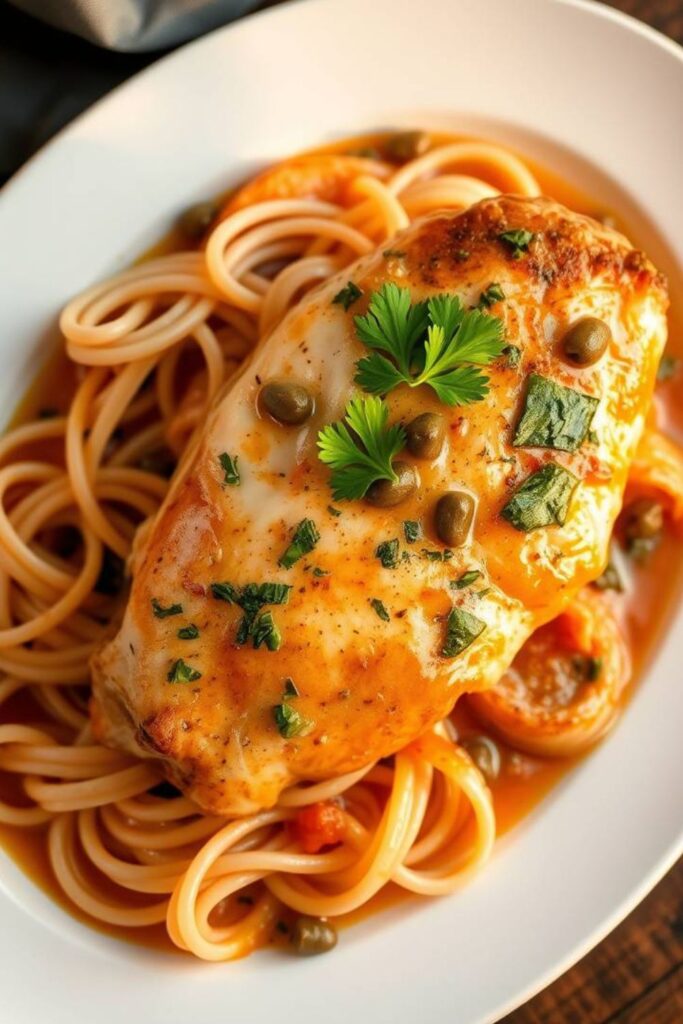
Let’s talk about why this technique works so beautifully. When you pound the chicken thin, you break down the muscle fibers, which makes the meat more tender. The flour coating creates a barrier that keeps the juices in while developing that gorgeous crust. This method is at the heart of a well made Chicken Piccata.
The wine serves multiple purposes, it deglazes the pan, adds acidity to balance the richness, and provides depth of flavor. When you add the lemon juice, you create a bright contrast that cuts through the butter and makes everything taste fresh and alive. These are signature flavors in a Chicken Piccata recipe.
Capers are the secret weapon here. These little flower buds pack a salty, tangy punch that elevates the entire dish. They’re like tiny flavor explosions, adding complexity without overwhelming the delicate chicken. In Chicken Piccata, capers are non negotiable. They define the dish’s bold identity.
The final butter swirl isn’t just for show, it’s an emulsion technique that creates a silky sauce with body and shine. This is why restaurant sauces look so much better than home versions. That little trick makes all the difference.
Making It Beautiful & Delicious
Presentation matters more than you might think. I like to slice the chicken on the bias and fan it out on the plate. Spoon that gorgeous sauce over the top, making sure to get plenty of capers in every serving.
A sprinkle of fresh parsley adds color and freshness. If you’re feeling fancy, a thin lemon wheel on the side looks professional and reminds people of the bright flavors they’re about to experience.
This dish pairs beautifully with so many sides. Creamy mashed potatoes soak up that sauce like a dream. Angel hair pasta tosses perfectly with any extra sauce. Even simple roasted vegetables become something special when they’re swimming in piccata sauce.
For wine, stick with what you cooked with, a crisp Pinot Grigio or Sauvignon Blanc echoes the flavors in the dish. If you’re more of a red wine person, a light Pinot Noir won’t compete with the delicate flavors.
Bringing It All Together
The beauty of Chicken Piccata lies in its simplicity and elegance. You take humble ingredients and transform them through technique and timing into something that tastes like pure luxury. This isn’t about complicated processes or hard to find ingredients, it’s about understanding how flavors work together and respecting the process.
What makes this recipe worth your time is its versatility. Master the basic technique, and you can apply it to pork, veal, or even firm fish. The sauce adapts endlessly, add mushrooms, switch up the herbs, or play with different citrus.
Here’s my final tip: don’t be afraid to taste as you go. Cooking is a conversation between you and your ingredients. If the sauce needs more lemon, add it. If it could use a pinch more salt, trust your instincts. The best cooks aren’t the ones who follow recipes blindly, they’re the ones who understand balance and adjust accordingly. That’s especially true when making Chicken Piccata, where the sauce demands your attention.
Remember, every great cook started somewhere. This dish might feel intimidating at first, but once you nail the technique, it’ll become second nature. Chicken Piccata rewards patience and precision. Before you know it, you’ll be the friend everyone calls when they need a recipe that’s guaranteed to impress.
What Goes Wrong and How to Fix It
Chicken turns out tough? You probably overcooked it or skipped the pounding step. Next time, use a meat thermometer and don’t be afraid to pull it off the heat when it hits 165°F.
Sauce won’t thicken? Let it simmer a bit longer to reduce, or whisk in a tiny bit of cold butter to help it come together.
Flavors taste flat? You need more acid, squeeze in extra lemon juice or add a splash more wine. Salt might be the culprit too, don’t be shy with seasoning.
Frequently Asked Questions Chicken Piccata
Can I make Chicken Piccata ahead of time?
You can prep the chicken and even cook it earlier in the day, but I’d recommend making the sauce fresh. The bright, lemony flavors fade when reheated, and the sauce can break if you’re not careful. If you must make it ahead, reheat gently and add a splash of fresh lemon juice to brighten it up.
What’s the best wine to use for cooking?
Use something you’d actually drink, doesn’t have to be expensive, just decent. Pinot Grigio, Sauvignon Blanc, or even a dry Riesling work beautifully. Avoid anything labeled “cooking wine” it’s usually loaded with salt and won’t give you the clean flavors you want.
Can I substitute the capers?
Capers really make the dish, but if you absolutely can’t find them, try chopped green olives or even small diced pickles. You’ll lose some of that unique briny flavor, but you’ll still get a nice tangy element that plays well with the lemon.
Why does my sauce always break?
This usually happens when the heat’s too high or you add the butter too quickly. Keep the heat at medium low when you’re building the sauce, and add that final butter gradually while swirling the pan. If it does break, a splash of cold water and some vigorous whisking usually brings it back together.
How do I know when the chicken is properly pounded?
You want it about ¼ inch thick throughout, roughly the thickness of a smartphone. It should feel tender when pressed but not falling apart. If you can see through it in spots, you’ve gone too far. Don’t stress about perfection, even thickness is more important than exact measurements.



